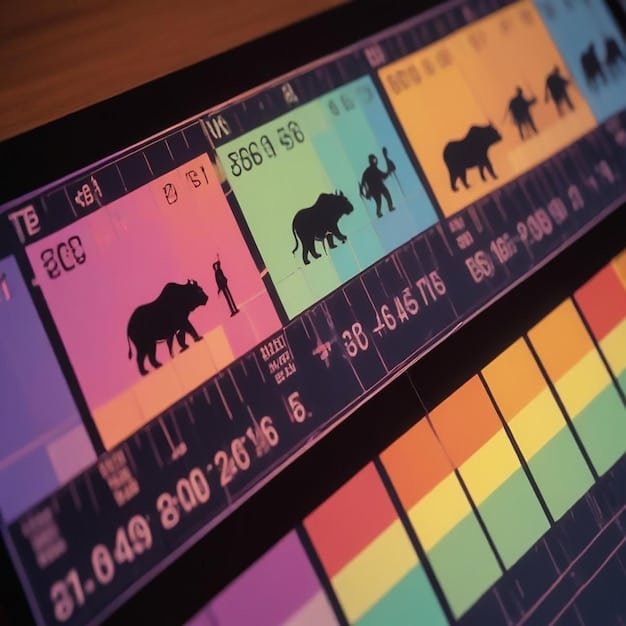Streaming Data Usage: Simple Ways to Lower Bandwidth Consumption

Streaming service data usage can be minimized by adjusting video quality, downloading content for offline viewing, monitoring data consumption, and utilizing Wi-Fi networks when available.
Are you worried about streaming service data usage eating into your monthly bandwidth? With video streaming becoming a primary source of entertainment, understanding how to minimize bandwidth consumption is essential for avoiding extra charges and ensuring smooth playback. Let’s explore effective strategies to manage your data while still enjoying your favorite shows and movies.
Understanding Streaming Data Consumption
Before diving into solutions, grasping how streaming devours data is crucial. Different streaming services and video qualities significantly impact bandwidth consumption, making it essential to evaluate your viewing habits.
Factors Affecting Data Usage
Several elements contribute to increased data consumption while streaming. Understanding these factors allows for informed decisions on reducing bandwidth usage.
- Video Quality: Higher resolutions like 4K consume substantially more data than standard definition (SD).
- Streaming Service: Different platforms have varying compression algorithms, influencing data use.
- Content Type: Movies often use more data than shorter videos or music streaming.
- Device: Some devices may default to higher quality settings, increasing data consumption.
Data usage is also affected by whether you are streaming over Wi-Fi or using cellular data. Wi-Fi networks typically offer unlimited data, whereas cellular plans often have strict data caps.

Estimating Your Streaming Needs
To manage streaming service data usage effectively, it’s important to estimate how much data you typically consume. This awareness can guide your strategies for minimizing bandwidth consumption.
Start by noting how many hours per day or week you spend streaming. Next, check the typical data consumption rates for the services you use. For instance, Netflix estimates about 1 GB per hour for SD content and up to 7 GB per hour for 4K Ultra HD content. Understanding these rates will help you manage data proactively, preventing overage charges and ensuring a seamless viewing experience.
In conclusion, understanding the dynamics of streaming data consumption lays the groundwork for devising strategies to minimize bandwidth usage. By recognizing the factors at play and estimating your consumption needs, you can take control of your streaming habits and avoid unnecessary data charges.
Adjusting Video Quality Settings
One of the simplest and most effective methods to minimize streaming service data usage is by adjusting video quality settings. Most streaming platforms offer customizable options that allow you to balance visual clarity with data consumption.
How to Change Video Quality
Adjusting video quality is generally straightforward and can significantly impact your bandwidth consumption. Here’s how to do it on some popular platforms:
- Netflix: Go to Account > Profile & Parental Controls > Playback settings. Choose from Auto, Low, Medium, or High data usage.
- YouTube: Click the gear icon on the video player and select Quality. Choose a lower resolution like 480p or 360p.
- Hulu: Go to Account > Playback Preferences and adjust the video quality settings.
- Amazon Prime Video: During playback, click the video quality settings on the player.
Lowering the video quality from 4K to HD or SD can reduce data consumption dramatically without significantly compromising the viewing experience on smaller screens.

Balancing Quality and Data Usage
Finding the right balance between video quality and data savings is key to optimizing your streaming experience. While reducing resolution can save data, it’s essential to consider the trade-offs.
For mobile devices and smaller screens, standard definition (SD) or low-definition settings might suffice, saving a considerable amount of data. On larger screens, such as TVs, high-definition (HD) might be preferable to maintain visual clarity. However, if you are streaming on a metered connection or have a limited data plan, opting for mid-range settings can strike an optimal balance. Experiment with different options to discover which settings best suit your viewing environment and data constraints.
In conclusion, adjusting video quality settings serves as an immediate and customizable solution to reducing streaming data usage. By understanding where to find these settings and how they impact your data consumption, you can balance viewing enjoyment with efficient bandwidth management.
Downloading Content for Offline Viewing
Downloading content for offline viewing presents a smart workaround for minimizing streaming service data usage. This method allows you to enjoy your favorite shows and movies without using any additional data once the content has been downloaded.
Benefits of Offline Viewing
Offline viewing offers multiple advantages beyond data conservation. It creates flexibility in viewing habits and ensures uninterrupted entertainment even when internet access is limited or unavailable.
Platforms That Support Downloads
Offline downloads are supported by a variety of streaming platforms, making it easier for users to manage their data consumption:
- Netflix: Allows downloads on mobile devices for most of its content.
- Amazon Prime Video: Offers extensive download options for movies and TV shows.
- Disney+: Enables downloading content for offline viewing on its mobile app.
- Hulu: Select plans offer download options for certain content.
Downloading over Wi-Fi and watching offline ensures that you’re not using your cellular data. This is particularly helpful during commutes or travel.
Managing Downloaded Content
Effectively managing downloaded content ensures that you maximize storage and minimize potential issues. Regular maintenance prevents storage overload and maintains an organized library.
Start by periodically reviewing your downloaded content to remove any shows or movies you’ve already watched. Most streaming apps provide tools for managing downloads, showing you how much storage each piece of content uses. Deleting content you no longer need frees up space and prevents your device from slowing down. Additionally, be mindful of download quality settings, as higher quality downloads consume more storage. Opting for lower quality when storage is limited can help you fit more content on your device.
Ultimately, utilizing the download feature offered by many streaming services is an effective way to minimize data usage while enjoying your favorite content. By selecting optimal download settings, leveraging Wi-Fi for downloads, and practicing regular content management, you can easily control your data consumption and view your shows and movies without interruption.
Monitoring Your Data Consumption
Keeping track of your data usage is essential for managing and minimizing streaming service data usage. Monitoring helps you understand your consumption patterns and identifies opportunities for optimization.
Using Built-In Monitoring Tools
Many streaming platforms offer integrated tools to help you monitor your data consumption directly from your account settings. These tools provide insights into how much data you are using and where it is being used.
For instance, most mobile devices provide a breakdown of data usage by app. Checking these settings regularly can give you a clear picture of which streaming services are consuming the most data. Some internet service providers (ISPs) also offer data usage trackers that you can access through their websites or apps. These tools typically provide daily or monthly usage summaries, allowing you to monitor your overall data consumption and avoid exceeding your data cap.
Setting Data Usage Alerts
Configuring data usage alerts is a proactive method to prevent unexpected overages and maintain control over bandwidth consumption. These alerts notify you when you approach your data limit, allowing you to adjust your streaming behavior accordingly.
- Mobile Devices: Set alerts on your phone to notify you when you reach a certain data threshold.
- ISPs: Many ISPs provide email or SMS alerts when you’re nearing your monthly data cap.
Receiving these alerts promptly enables you to make necessary adjustments, like reducing video quality or postponing non-essential streaming, ensuring you stay within your data limits for the billing cycle.
Analyzing Consumption Patterns
Analyzing your consumption patterns gives crucial insights into when and how you use the most data, helping you customize your streaming habits accordingly. This analysis is a proactive way to identify peak usage times and adjust your viewing habits to conserve bandwidth.
Start by tracking when you are most frequently streaming content—whether during evenings, weekends, or specific times of the day. Note which services you are using at these times and the video quality settings enabled. If you notice a spike in data consumption during certain periods, consider scaling back on high-resolution streaming during those times. For instance, if you stream the most on weekends, you might download content in advance or lower the streaming quality to avoid exceeding your data cap. Understanding these patterns helps you make informed decisions about your streaming behavior, ensuring you balance enjoyment with efficient data management.
To summarize, monitoring your data consumption is a critical component of minimizing bandwidth usage while enjoying streaming services. By taking advantage of built-in monitoring tools, setting data usage alerts, and thoroughly analyzing your consumption patterns, you gain the data required to make informed changes and manage your streaming effectively.
Utilizing Wi-Fi Networks
Leveraging Wi-Fi networks whenever possible is a straightforward yet effective method to minimize streaming service data usage. Connecting to Wi-Fi allows you to stream content without consuming your cellular data, which is crucial for those with limited data plans.
Benefits of Streaming Over Wi-Fi
Streaming over Wi-Fi offers a range of benefits, from conserving cellular data to providing more stable and often faster connections. It’s a practical solution for enjoying streaming services without the worry of data caps and overage charges.
- Data Conservation: Wi-Fi usage doesn’t count against your cellular data plan.
- Faster Speeds: Wi-Fi networks often offer faster and more reliable streaming speeds than cellular connections.
- Cost Savings: Avoid potential overage fees by using Wi-Fi for data-intensive activities like streaming.
By strategically employing Wi-Fi, you can optimize your streaming experience and avoid unexpected data expenses.
Finding and Connecting to Wi-Fi Hotspots
Locating and connecting to Wi-Fi hotspots can significantly reduce your reliance on cellular data, particularly when you’re outside your home or office. Taking a few simple steps ensures a seamless and data-saving connection.
Start by using your mobile device’s Wi-Fi settings to scan for available networks in your area. Many public places, such as coffee shops, libraries, and shopping malls, offer free Wi-Fi. When selecting a network, prioritize secure connections that require a password or registration, as they are generally safer. Once connected, confirm that your device is indeed using the Wi-Fi network by checking the Wi-Fi symbol on your screen. Regularly connecting to Wi-Fi hotspots when streaming content will help you conserve your cellular data and avoid potential overage fees.
In conclusion, harnessing Wi-Fi networks is essential for minimizing streaming service data usage. By taking advantage of the numerous benefits of Wi-Fi and learning how to find and connect to hotspots, you can ensure a smooth streaming experience without compromising your data limits.
Choosing Data-Efficient Streaming Services
Selecting data-efficient streaming services can notably reduce your overall streaming service data usage. Different platforms employ various compression algorithms and streaming technologies, which affect data consumption.
Comparing Data Usage Across Platforms
Various streaming platforms consume data differently, impacting overall bandwidth use. Evaluating these variations helps in choosing services that match your data constraints without sacrificing viewing quality.
Netflix, Amazon Prime Video, Disney+, and Hulu differ in their default streaming quality settings and compression methods. For instance, Netflix allows users to adjust data usage settings to a low of 0.3 GB per hour for SD content, while others may default to higher data usage. Conducting a side-by-side comparison based on data consumption per hour at similar video qualities can highlight the most data-efficient options. Online reviews and forums often provide user feedback and data consumption tests, offering additional perspectives. By choosing platforms known for their efficient data usage, you can enjoy streaming without exceeding your bandwidth limits.
Opting for Audio-Only Modes
Opting for audio-only modes in streaming apps can greatly reduce data consumption while still enjoying your favorite podcasts, concerts, or talk shows. This feature is particularly useful when video content isn’t essential.
Many platforms like Spotify, Pandora, and YouTube Music offer audio-only options that eliminate video streaming, significantly reducing data usage. For example, listening to music on Spotify consumes approximately 40 MB per hour at the normal quality setting, whereas streaming a video can consume significantly more. By switching to audio-only mode, you can enjoy uninterrupted listening while conserving bandwidth. Enable audio-only settings within the app’s preferences or settings to streamline data usage. This is especially beneficial during commutes, workouts, or when simply listening without the need for visual content.
In summary, making informed decisions about your choice of streaming service can significantly reduce your data usage. By comparing data consumption across different platforms and opting for audio-only modes when appropriate, you can effectively minimize bandwidth consumption and enjoy your content without exceeding data limits.
| Key Point | Brief Description |
|---|---|
| ⚙️ Adjust Quality | Lower video resolution saves data. |
| ⬇️ Offline Downloads | Download content via Wi-Fi to watch later offline. |
| 📡 Use Wi-Fi | Stream over Wi-Fi instead of cellular data. |
| 🎧 Audio-Only | Listen to audio-only versions when available. |
Frequently Asked Questions
▼
Streaming in HD typically uses around 3 GB per hour. Actual usage can vary slightly depending on the service and specific video encoding.
▼
Yes, you can reduce data usage on Netflix by adjusting your playback settings. Lowering the video quality to SD (Standard Definition) will consume significantly less data.
▼
Downloading movies over Wi-Fi and watching them offline is better for saving data compared to streaming them using cellular data.
▼
Not all streaming services offer offline downloads. Netflix, Amazon Prime Video, and Disney+ are among those that do, but availability varies by content and region.
▼
You can monitor your data usage on your phone through the device’s settings. Both Android and iOS have sections where you can view data usage by app and set data usage alerts.
Conclusion
Minimizing streaming service data usage is essential in today’s world, given the ubiquity of streaming services. By adjusting video quality, utilizing offline downloads, monitoring data consumption, and taking advantage of Wi-Fi, you can substantially reduce bandwidth consumption. Embracing these strategies ensures a sustainable and cost-effective streaming experience.





